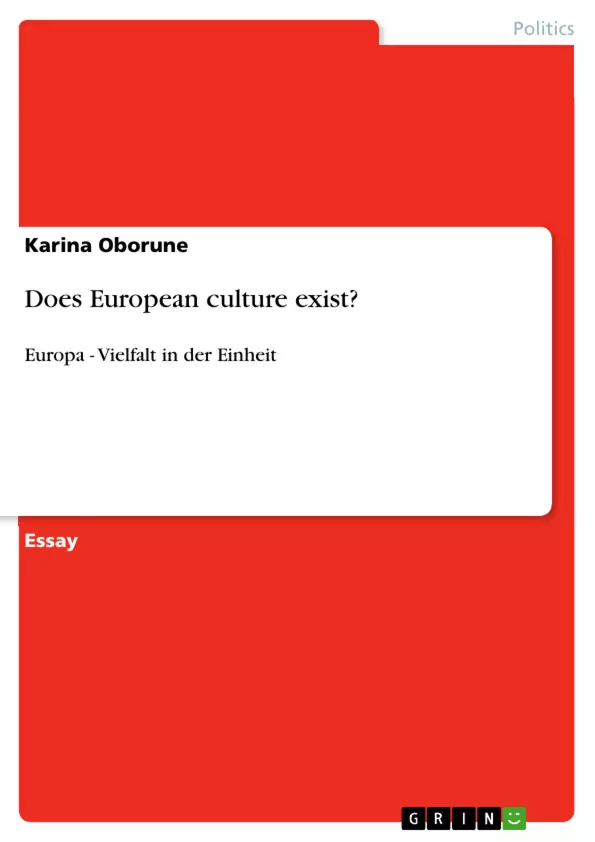“Even from different pieces of puzzle it is possible to make one European puzzle”(Georg Kreis)
European diversity in unity… Was it paraphrased mistakably or is it ironically contradicting the motto of the European Union “Unity in diversity”? And what kind of diversity we are talking about - cultural diversity, European diversity or diversity of languages? (Kreis: 2009) In author‟s turn she would like to speak about cultural diversity and put forward hypothesis that common European culture does exist.
Inhaltsverzeichnis (Table of Contents)
- Introduction
- Brussels as Babylon
- Long history of European culture
- No clear boundaries of European culture
- Unity in diversity or unity and diversity?
- Chicken in different colours
- Conclusion: European culture exists
Zielsetzung und Themenschwerpunkte (Objectives and Key Themes)
This text aims to explore the existence of a common European culture, examining its definition, historical roots, and its relationship with national cultures. The author argues that a shared European culture does indeed exist, despite the challenges in defining it.
- Definition and Concept of European Culture
- Historical Roots and Influences on European Culture
- Relationship between European Culture and National Cultures
- The Role of the European Union in Shaping European Culture
- The Paradox of Unity in Diversity
Zusammenfassung der Kapitel (Chapter Summaries)
- Introduction: The author introduces the topic of European cultural diversity and poses the question of whether a common European culture exists. She introduces the concept of "Unity in Diversity" and its possible contradiction with the reality of cultural differences in Europe.
- Brussels as Babylon: This chapter discusses the complexity and elusive nature of defining European culture. The author explores different perspectives on the concept of culture, highlighting its connection to identity, citizenship, and political order within the European Union.
- Long history of European culture: The author delves into the historical roots of European culture, tracing its development through periods like Ancient Greece, Roman civilization, Christianity, and the Renaissance. The chapter emphasizes the historical foundation of Europe's shared values.
- No clear boundaries of European culture: This chapter explores the challenges in defining the boundaries of European culture, noting the presence of faultlines and historical influences that shape cultural differences within the continent. It identifies various faultlines, such as the Roman Empire, the Catholic-Orthodox divide, and the Ottoman Empire's influence.
- Unity in diversity or unity and diversity?: The author examines the concept of "Unity in Diversity" as a cornerstone of European Union policy and explores its implications for the development of a shared cultural identity. She discusses Gerard Delanty's argument that "Unity in Diversity" is not the same as unity and diversity, suggesting that it promotes a specific form of cultural unity.
- Chicken in different colours: This chapter emphasizes the importance of preserving national cultures within the framework of a common European culture. The author stresses that European culture does not aim to replace or compete with national identities but rather seeks to create a shared space that encompasses and celebrates diversity.
Schlüsselwörter (Keywords)
Key words and topics explored in the text include: European culture, cultural diversity, unity in diversity, national cultures, historical roots, European Union, identity, citizenship, political order, faultlines, cultural policy, and the concept of "concordia discors" (unity in diversity).
- Arbeit zitieren
- Karina Oborune (Autor:in), 2009, Does European culture exist?, München, GRIN Verlag, https://www.hausarbeiten.de/document/156853


